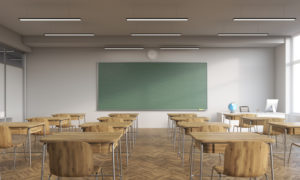There are approximately 100,000 public school buildings in the United States, approximately 40,000 of which do not have a plan for long-term facility care according to America’s Infrastructure report. As funding gaps continue to grow for public schools and immediate needs take precedence in budgets, districts should turn to technology to ensure they are prepared for inevitable breakdowns.
Portable classrooms, HVAC patches and more are merely stopgap measures for schools and should not be considered long-term solutions. This is how technology can help ensure longevity of public school buildings.
Identify Problems More Quickly
With environmental monitoring technology, schools can keep a constant eye on what’s happening in their buildings. There are so many different kinds of systems, from door access control to temperature, humidity, and water sensors, that can be used to detect a problem. When these systems are implemented and tied into an emergency alerting platform, such as SARA, schools are able to create a holistic monitoring system that can alert the proper individuals whenever an unwanted situation is detected. This allows school or emergency personnel to respond to any situation as soon as possible, potentially diverting dangerous outcomes or expensive damages to the school and its population.
What You Can Detect
According to the National Fire Protection Association, school structure fires cause $37 million in structure damage annually. School fires most often originate in the bathroom or locker room, which are both secluded areas that are not on camera and often have low foot traffic at different times throughout the day This can make it hard to determine the location of where a fire started, however, with a solution like SARA (Situational Awareness and Response Assistant), the right people can receive alerts to the fire’s location and the best exit route, not just its presence, which can help minimize damage. Other issues such as freezing pipes, non functioning HVAC systems, broken refrigerators/freezers, etc. can all be monitored with SARA as well. Having a system that constantly monitors for these events is essential for schools because they are only in session for approximately 180 days, which leaves another 180 days of unsupervised buildings in which issues can arise undetected. Implementing this technology allows you to automate these processes without having someone physically present when school is not in session.
Why It Matters
If an incident occurs during school hours, the safety of everyone in the building is at risk, which is why addressing the situation as quickly as possible is vital. If school personnel or emergency response services are provided with the right information, they can help resolve many of these problems before they cause major damage. Doing this is especially important because many students rely on schools for food, stability, and other things they may not be able to get from home, so if they close those students are at risk of harm.
As schools once again become fully operational following extended COVID-19 shutdowns, it’s imperative that student’s lives are disrupted as little as possible in the coming months and years. Two decades into the 21st century, technology holds the answer ensuring safety and security of future generations. So, what are you waiting for?
Check out Status Solutions’ offer to provide our platform at no cost to any school district throughout the country that elects to receive the life safety technology.

